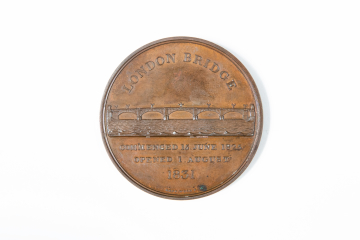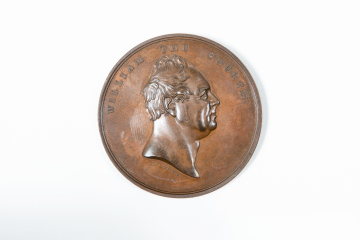Explore Collections


You are here:
CollectionsOnline
/
Commemorative medal struck to mark the opening of London Bridge by King William IV on 1 August 1831
Browse
Medal SDR21.17. ©Sir John Soane's Museum. Photo: Lewis Bush.
Benjamin Wyon (1802 - 1858), medallist
Commemorative medal struck to mark the opening of London Bridge by King William IV on 1 August 1831
Bronze
Inscription: WILLIAM THE FOURTH
Inscription language: English
Inscription language: English
Inscription: LONDON BRIDGE
Inscription language: English
Inscription language: English
Inscription: COMMENCED 15 JUNE 1823 / OPENED 1 AUGUST / 1831
Museum number: SDR21.17
Not on display
Curatorial note
Obverse: bare head of King William IV; Reverse: view of London Bridge.
The opening ceremony for the new London Bridge, designed by John Rennie, was held on 1 August, the anniversary of the accession of the House of Hanover to the British throne in 1714. A detailed account of the opening festivities appears in the Gentleman's Magazine, 1831, vol. II. pp.126 ff. The bridge was opened by King Willliam IV who, together with Queen Adelaide, attended a banquet in a pavilion erected on the bridge. A specimen of this medal in gold was presented to the King at the opening ceremony by the chairman of the committee; its whereabouts is not known. Bronze versions were sold to the public for 4s 8d each. Soane attended the opening and subsequently commissioned a large painting of the occasion by George Jones (SM P247). He bought two copies of the bronze medal.
The construction of the bridge had taken more than seven years and the total cost was reported to be £1,458,311.8.11d. Soane had followed the progress of the project, drafting a paragraph on the proposals for insertion in his Royal Academy lecture XI, apparently in 1820, commenting that 'Whenever this desirable work is undertaken, let us trust the construction will not be in iron', adding that an iron bridge of such an extent 'must be inconsistent with real or apparent strength and durabiltiy, and fatal to the distinctive character of a great public work', adding that iron bridges might 'in some degree be tolerated' in parks and pleasure grounds or over canals 'but never over rapid rivers intersecting populous cities', and concluding: 'They can only be looked upon as so many immense gridions suspended in the air'. Presumably he was delighted at the completion of the elegant new stone bridge made from Dartmoor granite.
The old London Bridge continued in use while this new bridge was built and was then demolished the following year, 1832. The new London Bridge in its turn had to be replaced and it was sold to the American entrepreneur Robert P McCulloch in 1968. He had it dismantled, transported to the USA and reconstructed in Lake Havasu City, Arizona.
The opening ceremony for the new London Bridge, designed by John Rennie, was held on 1 August, the anniversary of the accession of the House of Hanover to the British throne in 1714. A detailed account of the opening festivities appears in the Gentleman's Magazine, 1831, vol. II. pp.126 ff. The bridge was opened by King Willliam IV who, together with Queen Adelaide, attended a banquet in a pavilion erected on the bridge. A specimen of this medal in gold was presented to the King at the opening ceremony by the chairman of the committee; its whereabouts is not known. Bronze versions were sold to the public for 4s 8d each. Soane attended the opening and subsequently commissioned a large painting of the occasion by George Jones (SM P247). He bought two copies of the bronze medal.
The construction of the bridge had taken more than seven years and the total cost was reported to be £1,458,311.8.11d. Soane had followed the progress of the project, drafting a paragraph on the proposals for insertion in his Royal Academy lecture XI, apparently in 1820, commenting that 'Whenever this desirable work is undertaken, let us trust the construction will not be in iron', adding that an iron bridge of such an extent 'must be inconsistent with real or apparent strength and durabiltiy, and fatal to the distinctive character of a great public work', adding that iron bridges might 'in some degree be tolerated' in parks and pleasure grounds or over canals 'but never over rapid rivers intersecting populous cities', and concluding: 'They can only be looked upon as so many immense gridions suspended in the air'. Presumably he was delighted at the completion of the elegant new stone bridge made from Dartmoor granite.
The old London Bridge continued in use while this new bridge was built and was then demolished the following year, 1832. The new London Bridge in its turn had to be replaced and it was sold to the American entrepreneur Robert P McCulloch in 1968. He had it dismantled, transported to the USA and reconstructed in Lake Havasu City, Arizona.
Literature
W.J. Hocking, Catalogue of the coins, tokens, medals, dies and seals in the museum of the Royal Mint, Vol. II, London, 1910, 220/1
Jeremy Taylor, The Architectural Medal. England in the Nineteenth Century, London, 1978, 102a
Charles Welch, Numismata Londinensia, Medals struck by the corporation of London to commemorate important municipal events, 1831 to 1893, London, 1894, 1.
Jeremy Taylor, The Architectural Medal. England in the Nineteenth Century, London, 1978, 102a
Charles Welch, Numismata Londinensia, Medals struck by the corporation of London to commemorate important municipal events, 1831 to 1893, London, 1894, 1.
Associated items
Soane collections online is being continually updated. If you wish to find out more or if you have any further information about this object please contact us: worksofart@soane.org.uk




